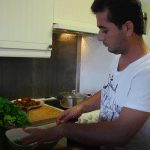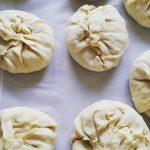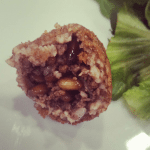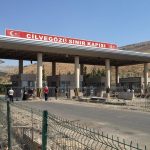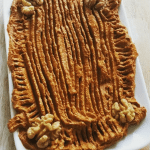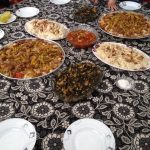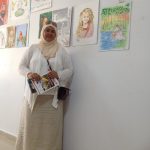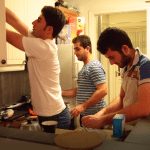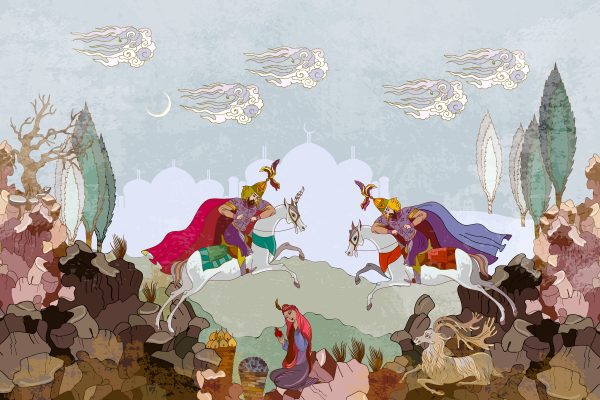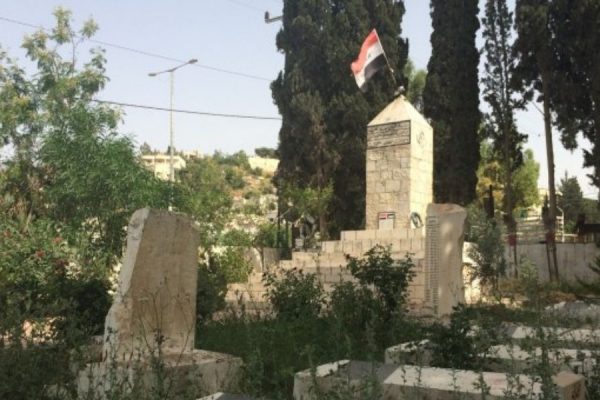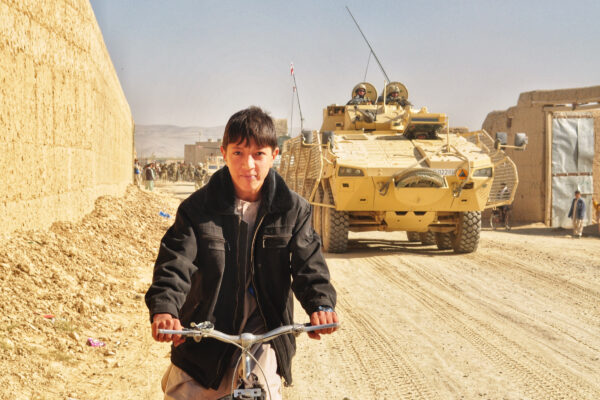Ozii is a hand-sized, flaky Syrian pastry filled with rice, peas and ground beef eaten with a yogurt sauce to cut the dryness. It is traditional funerary food and seemed the appropriate culinary endevour for my project.
My heart was breaking and I was looking for comfort. I watched Syria burn for five years. I followed the refugees as they journeyed through Europe, met with members of Congress and the Director of Homeland Security in hopes to help the Syria people. Nothing I did made a real difference. The situation in Syria only deteriorated and I felt like I was pouring water into the sand.
My solution was to enter the kitchen and start preparing Syrian food. This might be normal if I was Syrian, but I’m not. I was struggling to hold onto something that was quickly slipping away. At a subliminal level, I was cradling bits and parts of Syria in measuring cups, simmering pots, mounds of ground nuts and sauces stirred with wooden spoons. The Syria I came to know and love through its people was dying and it created a longing sadness that urged me to hold it, ultimately ingesting it and devouring Syria.
Syria is a large country with an 8,000-year-old culinary history that embraces its ethnic and religious diversity. The variety of Syrian gastronomy required a whittling down to produce a manageable menu. I looked through my cookbooks and chose a recipe for al mohamara, a chilli paste from Aleppo, similar in texture to hummus. I went over the recipe’s exotic list of ingredients, 12 chilli peppers, soaked in hot olive oil, 1 1.5 cup ground walnuts, ¼ cup pomegranate juice and a pinch of ground Arabic coffee. This was the kind of recipe I like to work with, rich in flavors and rich in history.
After soaking the chillies in hot olive oil, I massaged them and removed the seeds from the spine. I avoided touching my fingers to my eyes to avoid burning the tender membranes. Chillies, as well as onions, engage in chemical warfare. My mind drifted to the multiple chemical weapon attacks in Syria. It is difficult not to think of death and destruction when remembering Syria.
I ran all the chills through the food processor along with the onions, gradually adding in the ground walnuts and pomegranate juice. I tasted it. I love when a food has depth and complexity of flavor.
I added the Arabic coffee last. I wonder if coffee, like chocolate, would intensify the flavor. I added a pinch and taste. I added another pinch. The flavor started to wake up like a squeeze of lemon on fresh cut watermelon. There was deep beauty in this food and generations of knowledge accumulated in it. I wanted more.
My favorite Syrian food is kibbeh and the chefs of Halab (Arabic for Aleppo) are famous for their kibbeh and prepare at least 60 variations of this food. Kibbeh is made of bulgur wheat and beef to form a “dough” that is stuffed with pine nuts, spiced ground beef and is cooked multiple ways. I love them fried because they become delicious and crisp football shaped comfort food.
The preparation takes hours and it needs to be done in one sitting or the “dough,’ made of beef or lamb, bulgur wheat and onions all ground together to make a paste, dries out. The list of ingredients is simple and common, but the combination yields divinity on a plate. The key to this recipe, like so many seemingly simple recipes lies in skill. In the case of kibbeh, it lays in knowing the proper ratio and proportion of ground beef, onion and bulgur.Politics is very similar.
Politics is very similar.
The international community never got the ratio or proportion right in Aleppo, or anywhere in Syria for that matter. The U.S. along with the international community made a Syrian kibbeh that was too wet so it didn’t fry properly or too dry that it all fell apart while cooking.
In 2013, President Obama drew a red line in the sand concerning the use of chemical weapons. I was hopeful that real action would materialize when chemical weapons were used in Damascus a mere few feet away from U.N. inspectors; I was sure that international law would be enforced. After all, the United States invaded Iraq and removed Sadam Hussain over the suspicion of a stockpile of weapons of mass destruction. I was on the border of Syria on a bus from Gaziantep to the U.S. consulate in Addan, Turkey, when the situation escalated and Washington announced a possible air strike on Damascus. I was with a Syrian friend who was applying for a visa then.
When we arrived at the consulate, barricades were being put up. After entering, I was informed I would need to wait outside. There was nowhere I could go or hide. I was stuck there. At that moment, I half expected to die outside my own country’s consulate and glimpsed what it felt like to be Syrian, abandoned by my country and made a target.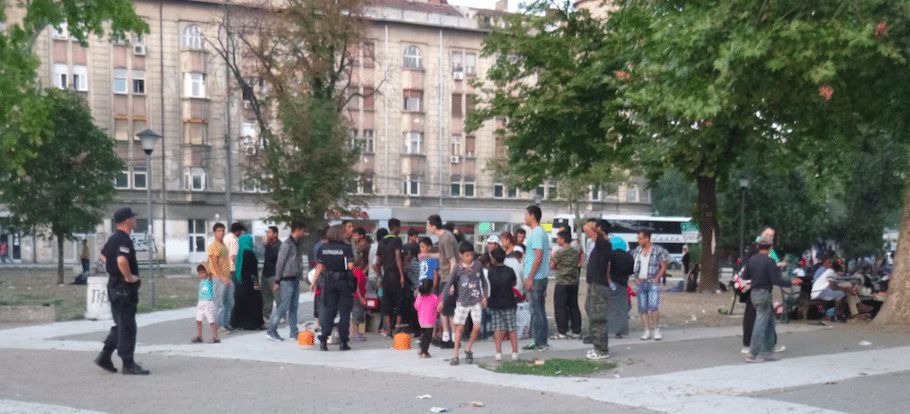
I was on my own.
Flash forward a year to June 2014 and I was back in Turkey in the living room of a family from Dier Ezzor, a region sandwiched between Iraq and Syria that obtained fame for being terrorized by ISIS. Despite their tormenting and resistance to ISIS, this region of Syria became synonymous with their antagonizers.
We ate okra that day. I usually do not like okra, but Dier Ezzor is famous for their okra dishes and I was eager to try. Most people do not know how to prepare okra so it does not become a mucilaginous mess. The trick is to not break the membrane when removing the stem. The people of Dier Ezzor mastered this skill and produced the best okra I ever had the pleasure of eating.I wonder if Al-Baghdadi likes the okra too.
I wonder if Al-Baghdadi likes the okra too.
ISIS was a disaster that Syrians and Syria watchers identified far in advance, but no one wanted to listen. Their rise was not sudden or unexpected. The world would not listen. Washington lacked the necessary skill to keep the membrane intact and instead ended up with a mucilaginous mess that flowed unchecked over Iraq and Syria.
As Al-Baghdadi prepared his announcement declaring himself khalifa, I stood on the opposite side of the Turkish border and looked out onto the mountains of Idlib, Syria. Back then I knew Turkey was about to become a dangerous place and decided that would be my last trip. It was a brewing disaster for anyone who wanted to see, but no one wanted to. It was a tragedy that would spread to Eastern Europe and then in the summer of 2015 the wave would hit Western Europe.
* * *
Serbia, July 2015. I was the only journalist on the ground in Belgrade a month before the refugee crisis hit a crescendo. It was not safe to bring a camera, so I settled for a number of hand-held devices to film a documentary I was working on. I was hoping that if I could get this story out into the world people would act. However, the situation had to hit crisis levels for the media to touch the story with any depth.
Most of my time in Belgrade I was afraid of being picked up by the secret police or the mafia who were smuggling the refugees. I was not prepared for what I saw and it was a 16-day kick to the stomach. I spent my nights in tears over what I saw and the frustration I felt at not being able to do anything. The only solace I found was a Lebanese restaurant that served kibbeh.
I was waiting for a group of Syrians from Idlib to arrive. Their ship sank and it delayed them. Only the older brother was in Serbia and I would not meet the rest of the boys in person until December in southern Norway. On my first trip to Norway, I interviewed them about their experience on the road and they were eager to share. I returned to Norway a second time to film a six-monthh follow-up in the summer of 2016. I was also on my way to the University of Oslo to study International Development.
I arrived in Mandal, Norway, a sleepy little fishing town teetering on the tip of Southern Norway looking across to Denmark. Over six months passed and I was not sure how the characters, the “boys,” were. I tried to stay in touch, but they were not very responsive.
Maybe they shared too much with me. They cried in front of me, a stranger and shared their intimate thoughts. Did I ask too much of them? I was a little shy showing up on their doorstep. I did not want them to think I was exploiting them. I wanted to tell their story in their own voice, but I could only do that with their help.
I pulled up to their apartment not knowing what to expect. I knocked on the door and the eldest brother answered. He was cooking. The younger brothers and cousin were out. The stove was filled with bubbling, frying and simmering pots. He ushered me in and I was overwhelmed by the hospitality. All of this was for me. I visited with them over the next four days. He cooked and I ate.It started to heal me.
It started to heal me.
I pestered him while he cooked and asked him the names of the foods and how to prepare them. It was a solace and for the first time in years, I felt like myself. I was back in the kitchen and I let myself enjoy the moment and thought of nothing else but chopped parsley fritters. Norway is a good place to heal.
Weeks later, I found myself sitting around the dinner table of a family from Hamma, the water wheel city. It was a few days before I left Norway to return home to the U.S. As I ate I thought about the Syrian culinary project I began in June. The more questions I asked the host about how she prepared the food, the closer I came to understanding why I wanted to cook Syrian food.
I found it when I entered my host’s kitchen and saw her potted gardenia. It should be in full bloom, but the glossy, green buds were shut tight against the tepid Norwegian summer. The gardenias, the Syrians were transplanted to a new country, struggling to preserve home. I was trying to preserve something too. I was holding on to the food, but I was also saying goodbye. I know many people are preparing Syrian food daily. They do not need my help to preserve or save anything. I wanted to save something for myself.
After seven weeks in Norway and years of travelling, I was back home and enthusiastic to get back into the kitchen. I dug up a recipe for mrabbet al ward – rose jam. It requires the Hasan rose which is indigenous to Aleppo, a city now reduced to rubble.
I started to think about those roses and wondered what their role is in the recipe. A chef, like a poet, selects every word, every ingredient for a reason, there is no is no arbitrarily addition. Every item adds something special to the texture, thickness, color, or it might be the ingredient that imparts a depth of flavor that leaves a delicate almost indescribable flavor at the back of the pallet, compelling the taster to take another spoonful to recapture the moment. And sometimes one ingredient is the cornerstone of a recipe and without it the end product is not the same. Is the Hasan rose that special je ne sais quoi? Every alteration to a recipe, even the location of a regional ingredient subtly changes the taste.
Aleppo’s roses, like the people who lived amongst them, are endangered. The last garden in the city dedicated to their preservation is closed because the caretaker died in one of the city’s daily attacks. Plants can grow other places when a plant travels it is never the same. Subtle and many times drastic changes happen to them, altering their composition forever, forcing them to adapt or perish.
Everything is leaving Syria these days. The layers of loss for Syrians are many and growing exponentially by the day, but we all share in their loss too. As Aleppo falls and those ancient monuments collapse and we allow the people of the oldest continually inhabited city to die, we lose a part of our shared cultural identity, but more importantly, we lose our humanity. In those simmering pots and mounds of ground nuts, I was holding onto my humanity, ingesting Syria to say, I care. I love you and goodbye.
